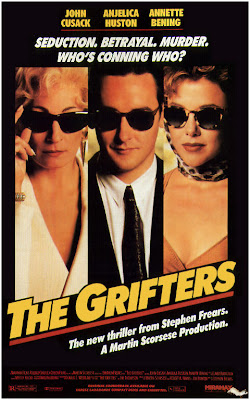Written by Robin Hitchcock
 |
| The Grifters poster |
The Grifters (1990) is a movie that’s been on my “to see” list for years. I knew it had epic critical acclaim at the time of its release. I’ve liked nearly every film I’ve seen by director Stephan Frears. I absolutely adore all three members of the main cast (Anjelica Huston, John Cusack, and Annette Bening). And it gets bonus points for having two women as central characters.
But when I finally caught The Grifters this week, it was a big disappointment. There are plenty of things to recommend about this film: It’s not quite like anything I’ve seen before even though it’s in the trope-heavy noir genre. There is some wonderful acting, with Anjelica Huston in particular delivering a riveting performance. Frears brings in some directorial flourishes worthy of the opening credit “A Martin Scorsese Production,” but others feel awkwardly dated, such as the disjointed flashback sequences.
What overshadows these good qualities is that The Grifters is incredibly unpleasant to watch. Unlike most con artist movies, there is no outsider “mark” character to identify with. Roy (John Cusack), his mother Lilly (Anjelica Huston), and his paramour Myra (Annette Bening) are all in the game. The question becomes, as the poster reads, “Who’s conning who?” [sic, I think; I went to public school ;)]
 |
| Seductress Myra (Annette Bening) |
But the question is actually a distraction from the real plot of the movie, a relationship-focused tragedy. None of the players is naive enough to trust anyone else, so no one gets conned. When Myra suggests to Roy that they team up, he flat out refuses. The inevitable betrayals and violence are all crimes of passion, not the planned schemes we’d expect.
 |
| Small-time con Roy (John Cusack) |
Seeing this play out is an exercise in misery. And here is where I must issue spoilery trigger warnings for incest and violence against women. One scene that turned my stomach so badly I did not recover for the rest of the film depicts Lilly being intimidated by her racketeering boss Bobo Justus (how’s that for a character name with “sub”textual meaning?) after she fails at the odds-fixing racetrack scheme she works for him. I can’t even bring myself to type a description of the scene, but it is available streaming online if you want to look for it. Lilly is clearly terrified of Bobo (with good reason), but treats him with a kind humility; she hopes her sweetness and deference can save her life. The terrible thing is that it’s clear her actions and demeanor aren’t what let her survive the confrontation, but rather the whims of the man terrorizing her.
 |
| Lilly (Anjelica Huston) |
Then there is the shocking violence of the third act, with such graphic gore as a woman with her face blown off on a morgue table. The Oedipal twinge to Roy’s relationship with Lilly, who had him when she was only 14 years old, comes to the fore in one of the film’s final scenes. I don’t enjoy incestual themes in any circumstances, but I found Lilly’s attempted seduction of Roy especially disturbing because she does it as a last-ditch effort to convince him to give her the cash she needs to flee Bobo’s wrath. It’s mutually non-consensual. It gets no further than a kiss, but that relief is immediately side-swept by more graphic violence.
And so The Grifters is a well-made and fantastically-acted movie that I would never recommend. Certainly some people will have a stronger tolerance than I do for its dark themes. My guess is that it’s easier to be entertained by this sort of thing when you are at the top of the kyriarchy like most film critics from the early 90’s (and sadly, today as well). But everyone else comes from a position of heightened awareness of their own vulnerability to violence and sexual assault. And that makes a movie like The Grifters seem more like a psychological weapon than a great film.
Robin Hitchcock is an American writer living in Cape Town, South Africa.
